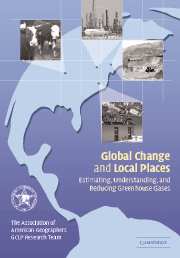Book contents
- Frontmatter
- Contents
- List of contributors
- Foreword
- Preface
- Acknowledgments
- Part One Global change and local places
- Part Two Learning from localities
- Part Three Beyond Kyoto I: greenhouse gas reduction in local places
- Part Four Beyond Kyoto II: greenhouse gas reduction potentials and strategies
- 11 Long-term potentials for reducing greenhouse gas emissions from local areas
- 12 Global change and local places: lessons learned
- Index
- References
12 - Global change and local places: lessons learned
Published online by Cambridge University Press: 31 July 2009
- Frontmatter
- Contents
- List of contributors
- Foreword
- Preface
- Acknowledgments
- Part One Global change and local places
- Part Two Learning from localities
- Part Three Beyond Kyoto I: greenhouse gas reduction in local places
- Part Four Beyond Kyoto II: greenhouse gas reduction potentials and strategies
- 11 Long-term potentials for reducing greenhouse gas emissions from local areas
- 12 Global change and local places: lessons learned
- Index
- References
Summary
Four major questions have informed the Global Change and Local Places research agenda from its inception:
How do the dynamics of greenhouse gas emissions and their driving forces differ at local scale?
Can localities reduce their source contributions to global climate change?
How and where does scale matter? and
How can the capacity to study global change in localities be improved?
The project's major findings, insights, and lessons can be cast as answers to these four key questions and as three major observations regarding the ways the global and the local relate to each other, stated as variants of the familiar slogan Think globally and act locally.
How do the dynamics of greenhouse gas emissions and their driving forces differ at local scale?
The importance of attention to local scale lies not in uncovering differences in descriptions of greenhouse gas emissions by major categories, but in details that are often lost in larger aggregations. The details in question are often critical to designing effective mitigation strategies.
Overall, 1990 greenhouse gas emissions for the four study areas are significantly, but not greatly, different from global, national, and their respective state level emissions (Chapter 7). Local emissions differ moderately in the mix of greenhouse gases, somewhat more so in sources, and considerably more in total per capita and per square kilometer emissions. Carbon dioxide dominates the mix of greenhouse gases at our sites as it does nationally (Table 7.3).
- Type
- Chapter
- Information
- Global Change and Local PlacesEstimating, Understanding, and Reducing Greenhouse Gases, pp. 239 - 260Publisher: Cambridge University PressPrint publication year: 2003
References
- 2
- Cited by

